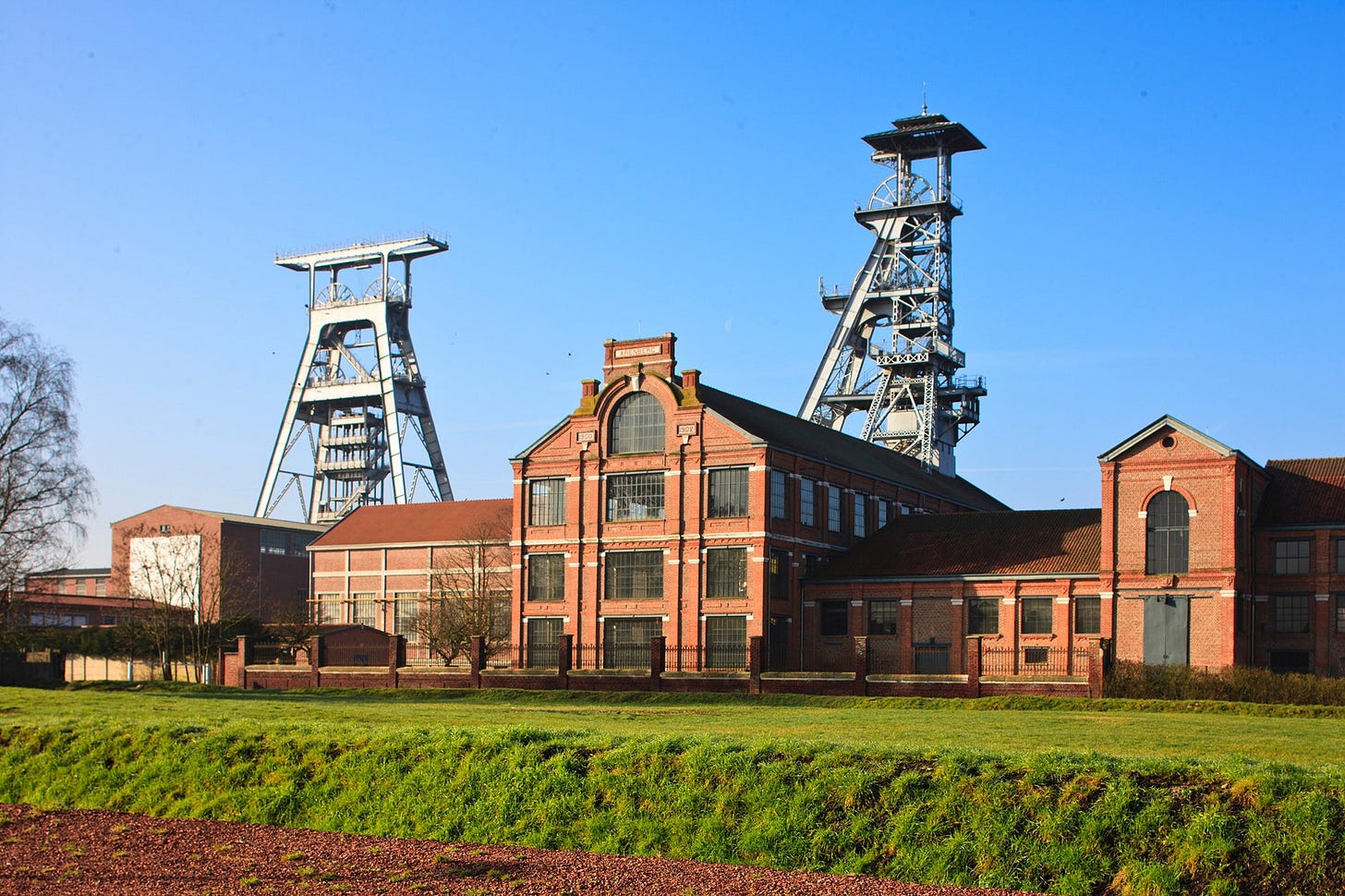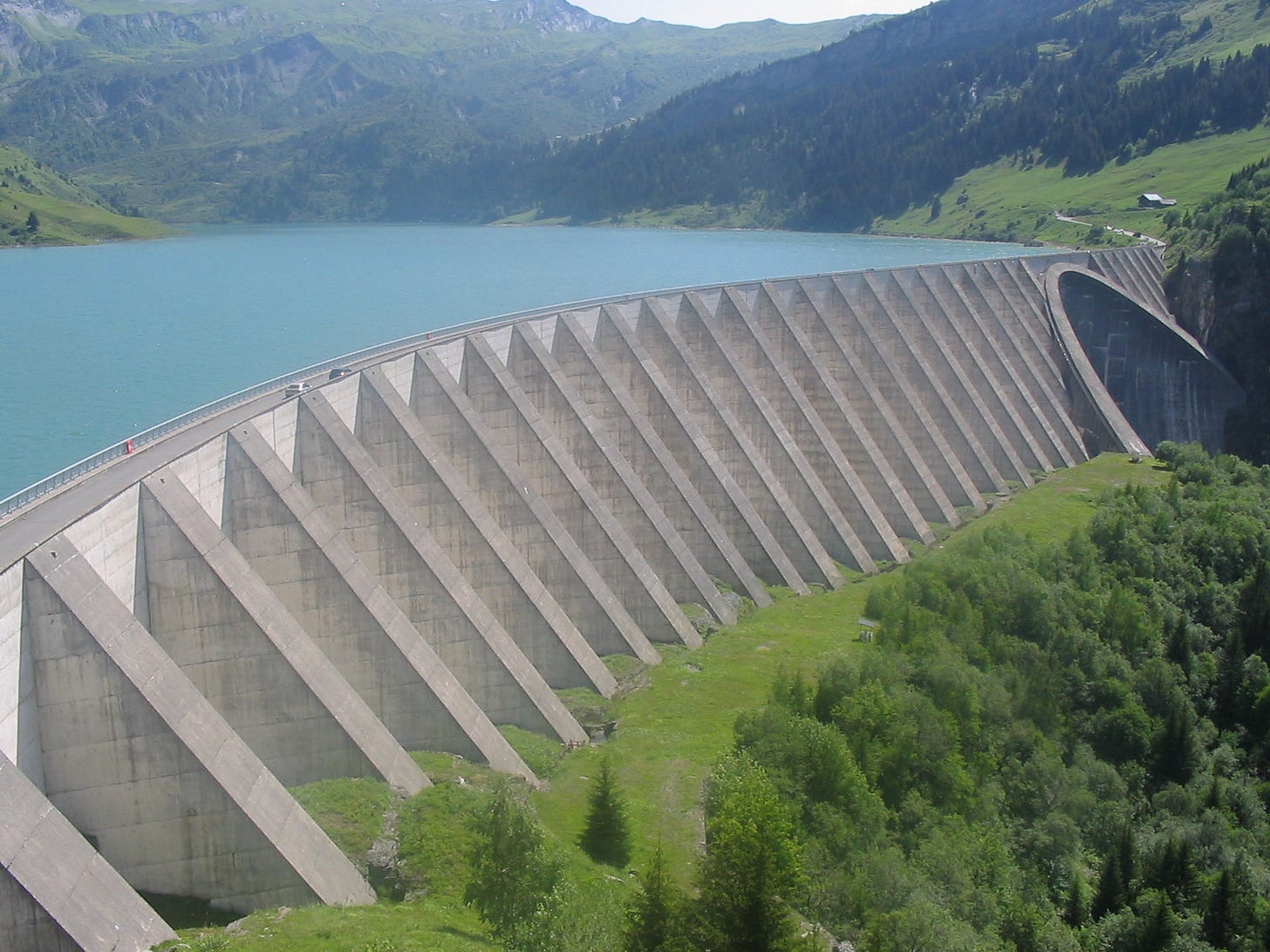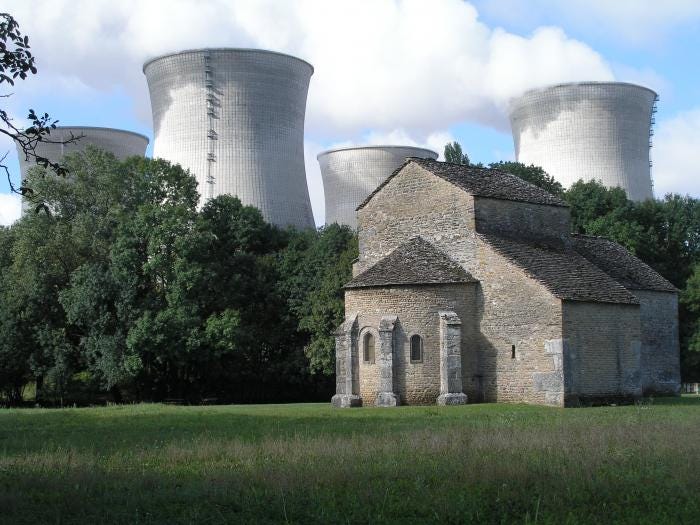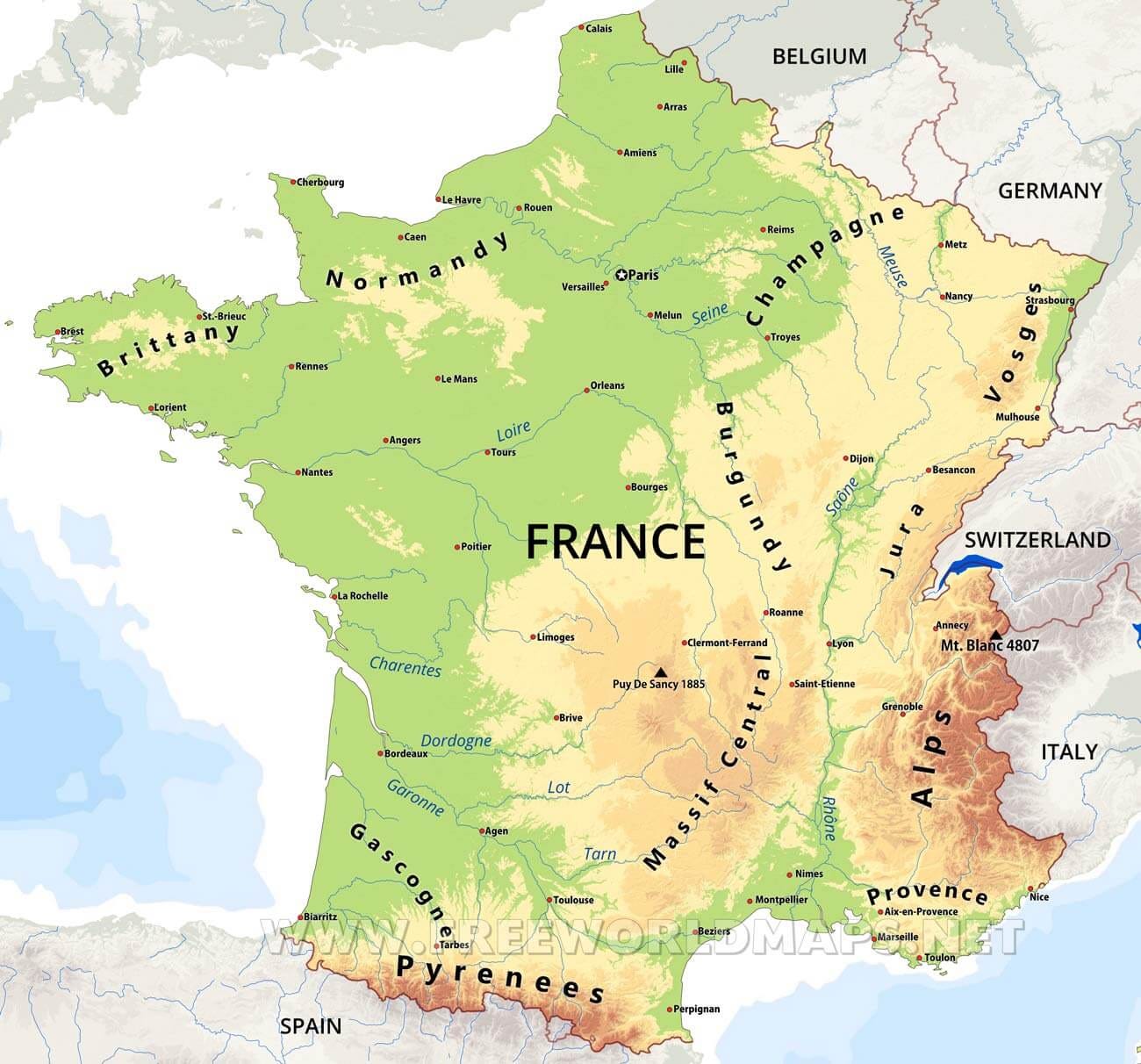A programming note: I have a child arriving on Monday, and although I’ve got the decidedly easier side of things, life is going to be a little bit more chaotic for a while.
The biggest race of the cycling calendar, the Tour de France, kicked off on July 1. It's the 110th edition, and while lesser energy blogs might use this opportunity to examine how much power some of the world's most elite athletes can output relative to the split system on your living room wall, or the energy they consume in order to race over mountain passes, Currently Speaking refuses to take the obvious route.
Declan has previously managed to weave his love of watching NSW lose Origin games into his articles, so let me indulge two of my favourite hobbies — cycling and gawking at power stations.1
So today, please follow me as we explore the power stations along the 2023 TdF route.
The 2023 Tour de France
For the uninitiated the Tour de France is a three week cycling stage race. Professional cyclists race in teams of eight over 21 stages (including two rest days). This year's race visits all five of France's mountainous regions — the Pyrenees, the Massif Central, the Jura, the Alps and the Vosges and covers a scarcely believable 3,400 km and 54,000 metres of climbing.2
Most stages are point to point affairs, starting and finishing in different towns. At the end of a stage (usually mid-afternoon) the entire peloton decamps and travels to the next town.
The overall winner of the TdF is the General Classification (classification générale), better known as the yellow jersey (maillot jaune), which is awarded to the rider with the lowest cumulative time across all stages (not the highest number of stage wins).
Like last year, the GC favourites this year are Slovenian Tadej Pogačar and Danish Jonas Vingegaard, both young cycling phenoms who between them have won the last three editions of the TdF.3 Heading into the final week they’re neck and neck.
There's plenty of Australians who lined up this year (twelve, to be precise), but Jai Hindley, a 2022 Giro d'Italia winner riding his first ever Tour is currently sitting in third position. He’s unlikely to beat the unassailable Pogačar or Vingegaard, but it’s a pretty big deal for Australian cycling.
This years race started in Bilbao, which is not France.4 Since the 1970s it’s very common for Le Grand Départ to start outside of France. It's (highly) improbable that we'll ever get a Grand Départ here in Australia, but you know, we live in hope and all that. Anyway I digress. The first stage to touch French land was stage 3, which started in Spain but finished in Bayonne, France.
The Contenders
Enough about cycling! Time to talk about the energy contenders we might see along the route.
If you know nothing else about the French energy system, you're probably aware that France is the poster child for nuclear energy. Facing declining coal reserves and an oil crisis in the early 1970s, they embarked on a campaign to build a large fleet of nuclear stations across the country. This legacy persists to this day with some 70% of annual energy being provided by nuclear making it the most nuclear-heavy country in the world.5
But France's generation mix is obviously more than just nuclear, including an interesting history of coal (and another cycling related crossover) and plenty of hydro, as well as the rise of wind and solar over the last two decades.
The Route
Thanks to the magic of the internet, I was able to overlay the 2023 TdF route with the locations of various power stations. However thanks to the walled gardens of modern platforms, Substack doesn’t allow dynamic HTML embeds; so please explore the interactive map here.
Global Energy Monitor proved an invaluable resource for power station data (along with the Millenial Dictionary and other random sources)6, as did Cycling Stage for the individual GPX route files.7

A History of Coal
France discovered coal in the 1700s and had an active and important history of coal mining; and perhaps the most significant region was the Nord-Pas-de-Calais mining region in the north of the country, bordering Belgium.
However post-World War II the mines were heading towards depletion and completely shuttered by the 1980s. In fact these diminishing coal reserves (and the increasing difficulty of mining what was left) were a key motivator in driving France towards the development of its nuclear industry.
Today France has no active coal mines and imports its coal from countries like Australia, South Africa and the US to supply the handful of remaining stations.
This year’s route doesn’t go anywhere near the few remaining active coal-fired stations. But if you’ve ever watched the Paris–Roubaix cycling race (which races from Paris to Roubaix, in a day), then you’ve seen the race go right past the prominent head frames of the Arenberg mine (now a UNESCO World Heritage Site), right before the race hits the iconic and brutal pavé section of the Trouée d'Arenberg (better known as the Arenberg Forest).

Gas
Like most developed nations France has a fleet of gas plants, including a decent number of modern combined cycle plants.
The closest gas station to the 2023 route is probably Bassens just outside Bordeaux, the end of Stage 7. But I can’t find much information on Bassens, so the next closest (and noteworthy) is probably the Bayet Combined Cycle power station, outside Clermont-Ferrand which Stage 11 passed through.
It’s a 401 MW combined cycle unit, commissioned in 2011. But honestly, short of explaining how combined cycle units work, I don’t have much interesting to say here. Gas units are sterile and boring; I’m not going to deny their importance to power systems globally, but they’re not pretty or architecturally interesting, nor are they physically impressive. The helicopter footage takes plenty of detours to pan over ancient castles and monasteries, it’s not wasting time on gas turbines.
Anyway, here’s a picture of Bayet to prove a point.

Hydro
Hydroelectric power in France is rather more interesting. For a country with five major mountain ranges, they’ve got plenty of hydro.
As might be expected the hydro units are all confined to the mountainous south and east of the country — the flatter central and northern regions of the country miss out.
A little more surprising is that the Alps is the only mountainous region with properly big stuff. The Pyrenees is home to only a few smaller (100MW and below) units, although this might relate to the very different topologies of the mountain ranges.
What is also interesting is that France is home to a lot of run of river hydro units; both the Rhône and Rhine Rivers host a string of consecutive units, often next to locks.
This year’s route goes very close to a lot of hydro units,8 so perhaps Stage 18 is of note because it goes right past two hydro stations — Belley, a 90 MW run-of-river plant on the Rhône (well, technical a canal deviating off the Rhône) and Bâthie, a 600 MW conventional gravity unit.

Wind
France, a big country, has a lot of wind — some 1,500 odd farms. Compared to Australia these farms are small — often only a dozen or two dozen MWs in size.
Interestingly for a big European country it currently has no offshore wind — but there are a good dozen offshore farms currently under construction or in development with the first farms to be commissioned later this year or early next.
Stage 8 which finished in Limoges went past a handful of mostly under construction farms, with a large belt of wind farms to the west of Limoges.
There are also quite a number of wind farms around Clermont-Ferrand, which was the finish/start point of three stages (9, 10, 11) which is somewhat unusual for the Tour.
Anyway, thousands of little wind turbines scattered across the countryside is an undenaibly good thing, but has me a little rien à foutre.
Solar
Early in Stage 7 the helicopter literally panned right over a solar farm. I was half watching the TV, and noted this, but didn’t note enough details to actually determine which farm it was.
It was probably either Labrit 1 (16 MW) or Gabardan (67.5 MW), both near Mont-de-Marsan.
After Stage 8 there’s a relative solar drought (they tend not to build solar farms in the mountains) until Stages 18 and 19.
France isn’t breaking any kind of records for building the biggest or most innovative solar farms, but solar is a significant and growing source of generation in the country.
Nuclear
I made you wait to the end for this. France is obviously famous for its nukes. It has 56 currently operating reactors with a capacity of 61 GW. All of the units are operated by Électricité de France (EDF), the majority state-owned company.
France’s nuclear power ambitions were set in motion by declining coal reserves and the 1973 oil crisis, leading directly to the Messmer Plan — an ambitious plan to ensure energy security named for the Prime Minister who enacted it9.
France scaled up and built a large number of units (the 900 MW CP0, CP1 & CP2 designs) in the first wave of construction during the 1970s and 1980s. It then became apparent that the projected electricity demand had not materialized, and the Messmer Plan had been over ambitious; the un-consulted French public may have been right to say tu me charriés.
Further units were developed and built in the 1980s and 1990s (and into the 2000s) with the 1300 MW P4 and 1500 N4 designs, mostly to replace ageing units.
Stage 13 and 18 (which overlap a section of road outside Lyon) pass by Bugey, which consists of four CP0 units (plus a retired pre-Messmer Plan unit).

Those same Stages also pass close to the retired Superphénix, a retired and controversial fast breeder reactor (and the biggest ever built, anywhere). This article is already way too long, but you should definitely detour to read about Superphénix; apart from the coolest name of any power station I’ve ever heard, it’s a unit with an interesting history.
The most recent French design, the 1650 MW EPR class which is also intended for export, has been a real problem child — the EPR design was intended to be used to replace the ageing French fleet this decade, but plans are currently on hold and the only unit actually constructed, Flamanville, still hasn’t been commissioned after a 10 year delay (current target early 2024). Hinkley Point C in the UK is also an EPR design and long running joke in the energy industry.10
There’s an entire article here in itself, and the Millenial Dictionary has a good summary, but a couple of points which I think are interesting:
France has benefitted from economies of scale by building lots of units of a consistent design. This is one of the key discussions around the success or otherwise of small modular reactors. But the flip side of the coin is that a fleet of units built to the same flawed design is a huge pain in the ass. Just ask EDF who found stress corrosion cracking in a dozen units built on the P4 and N4 designs last year.11
The French nuclear fleet is exclusively government owned, which makes it hard to determine the pure economic performance of these assets, especially when EDF is less than transparent around operating costs. Given that a significant number of units still in operation were built under the original enthusiastic Messmer Plan, the economics are further muddied.
The over-abundance of nuclear capacity means that French nukes often run at capacity factors around 60%, which is much lower than the typical nuclear capacity factors of 80-90%. France is often a net exporter of electricity to its neighbours, but without additional transmission build out this ability is limited. With the growth of solar and wind, these capacity factors are not getting much better.
The Final Week
On paper predicting that either Vingegaard or Pogačar will win this year’s Tour again sounds extremely boring, but the racing has been anything but. The 110th edition has been properly exciting with a very challenging route and aggressive racing from the very first stage.
Likewise, “Power Stations of the Tour” started as a bit of a joke, and ended up being a lot more interesting and than I thought it would be. There’s a million rabbitholes I wish I had more time to dive down, but alas this article is already too long and I don’t have the time.
So next time you’re watching the Tour and the helicopter starts showing shots of centuries old monasteries and castles, keep your eyes peeled for power stations too.
The Vuelta a España starts in late August…
Things Happen
Do you find the talking heads of Sky News After Dark a little too leftie for your tastes? Good news! Alan Jones’ new ADH TV which is aiming to be the Newsmax of Australia has received funding from James Packer. We’re looking forward to hearing balanced and nuanced discussions around the energy transition.
The Conversation has an interesting piece summarising the history of nuclear in Australia and why nukes aren’t in the future roadmap here.
Matt Levine has a good and amusing insight into the green-washing of oil companies via infrastructure partnerships. And separately, how you can become filthy rich by existing in the amoral morass between green-washing and stranded assets, if you play your cards just right.
This joke worked better before Queensland lost the third game. But whatever, EIGHT IN A ROW.
This elevation is the important number — a good cyclist can spin along all day on the flat; that’s not particularly impressive.
Familiar names if you've watched the Tour de France: Unchained documentary on Netflix, a Drive to Survive copy covering the events of the 2022 TdF.
(it's Spain. FYI)
Although both the US and China generate more total energy (TWh) from nuclear per year.
After I’d spent rather too long gathering data from various disparate sources I discovered that GEM has incredibly rich datasets on everything I wanted. Really could have saved myself some time there. Also could have imported more metadata into the map, including filtering out some of the solar and wind farms not yet commissioned and operating. ¯\_(ツ)_/¯
I made the above with the very wonderful gpx.studio tool, which lets you paste multiple gpx files together and reduce the number of individual waypoints, allowing compatibility with Google Maps and GPS headunits. If you like riding or running very long distances, this is a handy tool.
Duh, cycling races often go up mountains.
It’s worth noting here that France has quite limited domestic uranium supplies, but nor does it have oil (or gas), so when the coal is running out nuclear and hydro are the most prudent decisions in the 1970s.
The Chinese have two operational EPR units at Tashain, but they also were not without significant technical problems and construction delays.
Solar and wind also benefit from modular designs. But unlike nuclear these industries have a much higher number of competing companies and competing designs. So yes, design flaws propagating through a whole bunch of wind farms is entirely possible, but it’s less likely that large portions of the fleet are built to the same flawed design.







Brilliant juxtaposition of electrical power and 🚴♀️ races. Love your work.
The Banc de Guerande offshore wind has operating since more than 6 months now you can see here all the plants :
https://energygraph.info/d/WC9L4zIVk/production-capacities?orgId=1